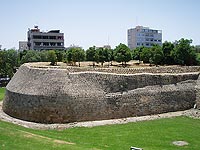
In the history of Nicosia, many played a role including Venetians, Ottomans, British and more.
 |
the north cyprus travel guide |
 |
|
Nicosia History
When you visit North Nicosia (or Lefkosa) on your North Cyprus holiday, you’ll be visiting one of the few important cities in the Mediterranean not located on a major river or on the coast. Nicosia has always been near the centre of Cyprus, surrounded by land and with no means of reaching the city from the sea in ships. However, this was a deliberate choice that has stood Nicosia in good stead through turbulent times during the city’s history. (It also means it’s easy to reach from Ercan airport after your flight to North Cyprus!) Nicosia, North Cyprus: Early DaysAlthough there are Bronze Age settlements in North Cyprus near Nicosia, the first major city on the site was Ledra, founded in 280BC by Lefcon, the son of Potolemy Soter. It is thought that this original city lies almost exactly under the fortified area of Nicosia today. The city rose in prominence over the centuries, and by 1211 had a sturdy castle to defend it, and a system of walls. Probably known as "Cossia" at this time, it was a wealthy city, whose rich merchant citizens enjoyed a luxurious lifestyle in their elegant houses. The cathedral of St Sophia, and the church of St Catherine both date from this period. However, all this changed in 1426, when the Egyptian Mamalukes invaded Cyprus. King Janus of Nicosia was captured and his royal palace burnt to the ground, and the city of Nicosia was partially destroyed. Nicosia, North Cyprus: Venetian Rulers and WallsThe Venetians arrived in Nicosia in 1489, took one look at the sprawling city, and decided that if it was to be properly defended, the area of the walled city would have to be smaller. They reduced the circumference of the city by some three miles, and built their strong defensive walls that you can still see today on your North Cyprus holiday visit to North Nicosia. However, the Venetians also realised that beyond the walls there should be a wide, open space with no cover for any advancing enemy. That meant destroying many of the fine Lusignan buildings that lay beyond their walls, including the Abbey of St Domenico, where many Lusignan kings were buried. Now the Venetians had a city circled by thick walls, able to withstand cannon fire, and they were about to need them. The Ottoman invasion of 1570 saw the Turks lay siege to the city. Despite strong resistance, and the super-sized walls, Nicosia fell within seven weeks, with the loss of many lives on both sides. Nicosia, North Cyprus: Ottoman RuleThe Ottomans remained the rulers of Nicosia, or Lefkon as they called it, for three hundred years, and many of North Nicosia’s most beautiful buildings date from this period. In 1878, the British annexed Cyprus when Vice-Admiral Lord Hope raised the Union Jack flag in Nicosia. Nicosia became the capital again, and in between the existing buildings, the British built everything else they needed, from fine houses to a brand new post office. The city remained the centre of British administration until the events of 1974, when the city became divided in the conflict between north and south. North Nicosia, Northern Cyprus: The Green LineThe border between North Cyprus and the south was drawn right through the middle of the city of Nicosia, such that the traditional Turkish area in the north and the Greek Cypriot areas in the south of the walled city were divided. The UN established and still maintain this border, known as the Green Line since it was first drawn on a map by a British officer in green ink. For many years, it was only possible to pass across the Green Line for a day visit, but now the border restrictions are much more relaxed, and people can move freely between North Nicosia and the south. The Nicosia Master Plan has been successfully restoring important buildings in both halves of the city, an important step in hopefully bringing the two parts of this divided city together again in the future. |
|
North Cyprus quick: holidays | flights | hotels | property | kyrenia | famagusta | photos | map | weather | history | news
All text is copyrighted by Cyprus44. Photographs are copyrighted by their respective photographers.
For more information read our copyright policy, privacy policy and disclaimer.
This web page is served on 15 September 2025 at 8:46:40 AM.
![]()
Cyprus44 in other languages: Nordzypern | Chypre Nord | Severní Kypr | Северный Кипр
partner sites: goNorthCyprus Travel | Pacific Rent-A-Car | Amy Holiday Villas | other partner sites







